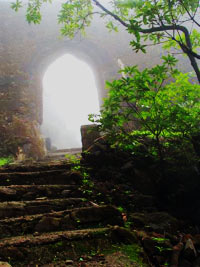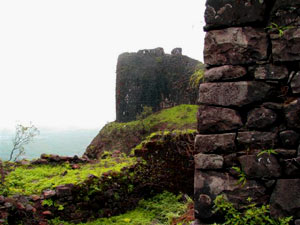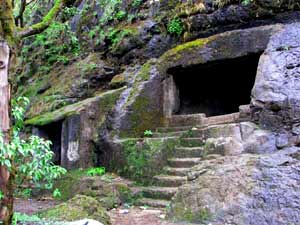 It looms out of the mist like the prow of the Titanic; enigmatic and majestic, caped in the monsoon green so typical of the region. Koraigarh (or Korigarh), in the vicinity of Lonavala, is a day's nature walk, ideal for the monsoon season when it is a verdant green, swathed in chill mist at the top. It looms out of the mist like the prow of the Titanic; enigmatic and majestic, caped in the monsoon green so typical of the region. Koraigarh (or Korigarh), in the vicinity of Lonavala, is a day's nature walk, ideal for the monsoon season when it is a verdant green, swathed in chill mist at the top.From Lonavala towards Aamby Valley is a 20 km drive past innumerable waterfalls, till one reaches Shahpur (Shivpur) village where you park your car and pay a local shop keeper to look after it. From there it is an hour's easy, but fascinating, walk up the hill. | |||||
 Around the base of the fort there is dense jungle. A path through it takes one to the steps of a fort. This jungle, with dense bamboo thickets, abounds in flora and a fascinating variety of birds and insects. The steps are steep but not very taxing for the average person. At about the halfway mark there are some caves and a view point from where one gets one's first panoramic view of Aamby Valley. There is also a small Ganesh Mandir. Another 15 minutes climb gets one to the top, via an ill-maintained entrance gate to the fort. Like most main entrances to a fort, this is parallel to the walls. The reason for this is to prevent the enemy from being able to gain momentum in a charge to storm the gates. Around the base of the fort there is dense jungle. A path through it takes one to the steps of a fort. This jungle, with dense bamboo thickets, abounds in flora and a fascinating variety of birds and insects. The steps are steep but not very taxing for the average person. At about the halfway mark there are some caves and a view point from where one gets one's first panoramic view of Aamby Valley. There is also a small Ganesh Mandir. Another 15 minutes climb gets one to the top, via an ill-maintained entrance gate to the fort. Like most main entrances to a fort, this is parallel to the walls. The reason for this is to prevent the enemy from being able to gain momentum in a charge to storm the gates.Koraigarh is particularly devoid of fortifications, very few crenellations, loop holes and other trappings of the more formidable forts in Maharashtra. The fort is not a complex one, it does not appear to have been made to fight a determined enemy. It seems to be either a garrison fort from where distant rulers enforced their writ or a famine relief project. This is apparent from the rudimentary walls which seem only to supplement the natural scarp of the hill. Only at a few places is the fort wall more than just a basic parapet of stone. One such place is, understandably, astride the entrance. Here, there is a tower and more developed defenses. Inside the fort too, the construction is not elaborate. All one can now see are the ruins and the shape of the plinths, but these do not indicate any grand buildings or palaces. This reinforces the idea that being a garrison; the buildings were more utilitarian barracks. The temple of Korai Devi, after whom the fort is named, appears to have been built much after the fort.  Inside the perimeter, the walk is a naturalist's delight. The ecology is centered around two ponds that are teeming with life. The most striking is the deafening bull frog chorus: thousands of frogs in curious symphony. The food chain was demonstrated by the presence of a large number of tiny water snakes, land crabs and a multitude of insects. Inside the perimeter, the walk is a naturalist's delight. The ecology is centered around two ponds that are teeming with life. The most striking is the deafening bull frog chorus: thousands of frogs in curious symphony. The food chain was demonstrated by the presence of a large number of tiny water snakes, land crabs and a multitude of insects.
A walk around the ramparts gives a wonderful panoramic view of the surrounding country, primarily Aamby Valley which lays siege to the fort from nearly three sides.Of course our lesser ecologically minded friends have left a trail of empty bottles and food packets all over in a place seemingly bereft of any garbage clearance system. The best time to visit is early in the morning when one has the place to one's self. Later in the day it can get quite crowded, especially on weekends.
A monsoon walk in the mist and light rain is a truly recommended day out with the family.
Photo Credit: Brig (retd.) Xerxes P Adrianwalla
| |||||
Tuesday, 11 November 2014
Trek To Koraigarh Fort
Labels:
Aamby Valley,
fort,
history,
Korai devi,
Koraigarh,
Lonavala,
Maharashtra forts,
monsoon,
Sahyadri,
trek
Subscribe to:
Post Comments (Atom)
No comments:
Post a Comment